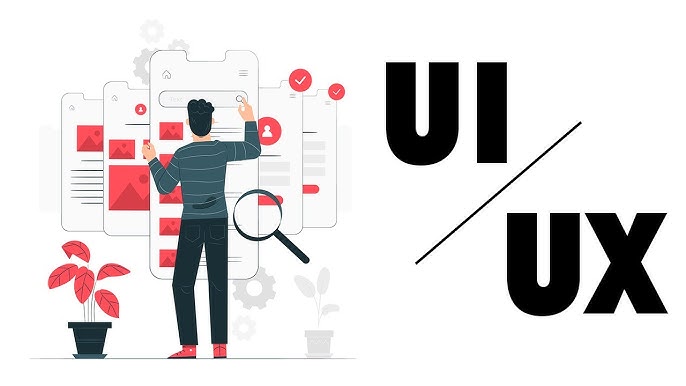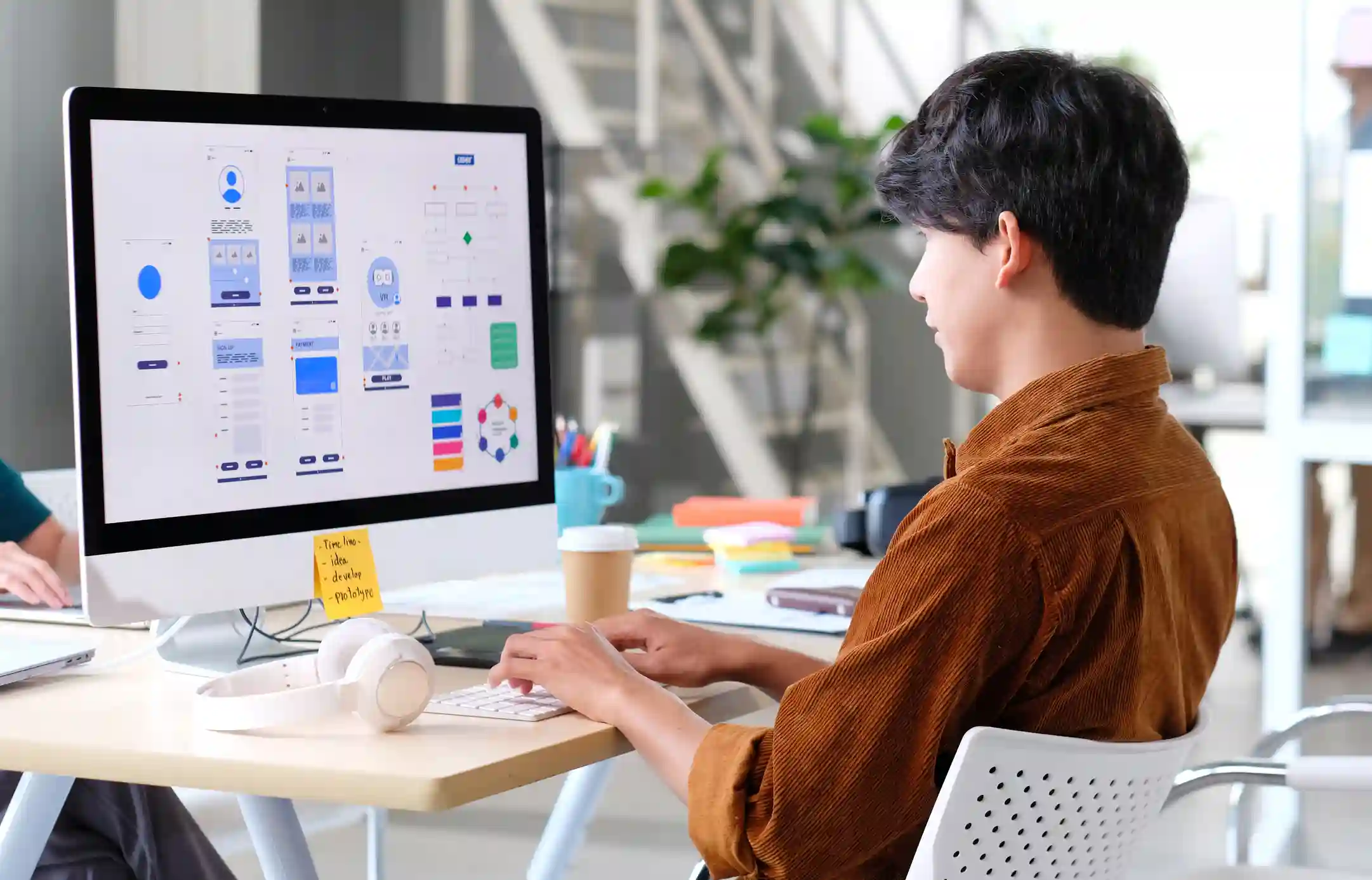UX Design
The Impact of UX Design on Your Online Conversions
In today's digital landscape, where competition is fierce, the UX design (User Experience) plays a key role in the success of a website. A well-designed user interface is no longer enough; it is now crucial to create a user experience fluid and pleasant. The UX design refers to the set of processes aimed at improving the interaction between a user and a site or application, with an emphasis on ease of use, efficiency and enjoyment.
The main objective of the UX design is to maximize visitor engagement while facilitating their journey through the site. This includes intuitive navigation, fast loading times, and relevant content, all designed to meet user needs.
In this blog, we will explore how a optimized UX design can significantly improve the conversion rateWhether it's simplifying navigation or improving calls to action, good UX design turns visitors into customers. You'll discover why investing in a UX strategy is essential for the success of your online business.
What is UX Design?
THE UX design (User Experience) refers to the set of practices aimed at improving the interaction between a user and a website or application. It's not just about creating a visually appealing interface, but also about designing a path that allows users to achieve their goals in a simple, intuitive, and efficient way. UX design considers elements such as ease of navigation, speed of access to information, and fluidity of interactions to provide a pleasant and engaging experience.
Difference between UX and UI
It is important to distinguish the UX design of UI design (user interface). The UI design focuses mainly on the visual appearance and arrangement of elements of a site or application: colors, buttons, typography, etc. On the other hand, the UX design is more about the overall feeling users have when interacting with these visual elements. While the UI is focused on appearance,UX focuses on how users perceive and interact with the product.
Key Objectives of UX Design
The goal of UX design is to make the user experience as smooth and enjoyable as possible. Here are some of its main objectives:
- Make navigation easier : UX design aims to simplify the site architecture, allowing users to easily find the information they are looking for.
- Improve the overall experience : By eliminating friction points and optimizing each step of the user journey, good UX design contributes to a feeling of satisfaction, thus strengthening user loyalty.
- Increase engagement : Effective UX design encourages users to engage more with content, increasing conversions and ROI.
Investing in a well-thought-out UX design is crucial to maximizing user satisfaction and improving your site's overall performance.

Why UX Design Is Crucial for Online Conversions
THE UX design is one of the most important factors in successful online conversions. It directly influences how users interact with a website, from their first contact to the final action, such as a purchase or registration. optimized UX design can turn visitors into customers by making their journey easier and improving their experience.
First Eye Contact: The Importance of First Impressions
THE first visual contact is essential in the digital world. From the first few seconds, a visitor forms an opinion about a site. If it is not attractive or confusing, the user is likely to leave quickly. A well thought-out UX design, with a clear and pleasant interface, immediately captures attention and encourages further exploration.
Simplicity and clarity: Reducing bounce rate
There simplicity and the clarity are pillars of UX design. A site with a intuitive navigation and clearly presented information reduces the bounce rate, that is, the percentage of users who leave the site after visiting just one page. The easier it is for visitors to find what they are looking for, the more likely they are to stay and convert.
Loading time and mobile responsiveness
A slow or poorly mobile-optimized site can discourage users and decrease conversion rate. Fast loading times and a mobile responsiveness ensure a seamless user experience across all devices, which is crucial in a world where mobile increasingly dominates online interactions.
Concrete examples
Well-designed sites, such as Amazon Or Airbnb, show how much the UX design can improve conversions. These companies have invested heavily in user experience, resulting in a significant increase in conversions and increased customer loyalty.
Key UX Design Elements That Affect Conversions
A UX design effective is based on several essential elements which play a determining role in the optimization of online conversionsThese components, although varied, all converge towards a common goal: improving the user experience to encourage action.
Simplified navigation
There navigation is a central element of the user experience. A clear and logical menu Allows visitors to easily find the information they are looking for, reducing the risk of abandonment. Complex or disorganized navigation can frustrate users and cause them to leave the site. By adopting a simplified approach, users spend less time searching and more time interacting, which leads to better conversion.
Optimized call-to-action (CTA)
THE CTA are crucial elements to guide the user towards a specific action, whether it is a purchase, a registration or a contact request. A Well-placed CTA and visually appealing captures attention and encourages action. It is essential to test different wordings and placements to maximize the effectiveness of CTA and encourage conversions.
Fast loading time
THE loading time of a site has a direct impact on conversions. The faster a site loads, the more likely it is that visitors will continue browsing and take action. Studies show that a loading time of more than a few seconds can lead to significant loss of usersOptimizing your site speed is therefore a powerful lever for increasing conversions.
Readability and visual structure
There readability plays a key role in how users consume content. A clear typography, well-spaced paragraphs and effective visual hierarchy make it easier to read and understand. If the content is difficult to read or visually confusing, users will be less likely to interact with the site, reducing the chances of conversion.
How UX Design Improves User Engagement
A UX design Well-designed UX design can significantly increase user engagement by creating intuitive, seamless, and personalized experiences. By addressing visitors' specific needs, UX design helps reduce frustration and encourage longer interactions.
Personalization: Offer a unique experience to each visitor
There customization is a key factor in user engagement. By tailoring the interface and content to the individual needs of visitors, you create a unique experience that captures their attention. Personalized recommendations, based on past behaviors or preferences, increase user engagement. A site that delivers relevant content based on user actions not only improves engagement, but also the chances of conversion.
Seamless Interaction: A frictionless interface to encourage engagement
A smooth interface barrier-free environment promotes prolonged interaction. If users can navigate easily and quickly find what they are looking for, they will be more likely to interact with the content. Smooth transitions, quick responses, and accessible information reduce frustration. Thus, the absence of friction encourages deeper exploration of the site, increasing the chances that the user will complete a desired action, such as a purchase or registration.
Reducing Shopping Cart Abandonment: The Importance of a Simple and Intuitive Checkout Process
A complex payment process is one of the main reasons why users abandon their shopping cart. Effective UX design makes the purchasing journey as simple and intuitive as possible. By optimizing every step, from product selection to purchase completion, you reduce abandonment and increase conversions. Clear instructions, multiple payment options, and transparent costs all reassure the user and make it easier to complete the transaction.
Case Studies: The Impact of UX Design on Brands
THE UX design has a direct impact on the online performance of businesses. Many brands have seen their conversions increase after optimizing their user experience. Here's a real-life example that illustrates the positive effect of UX design on a company's bottom line.
Example of a company that optimized its UX to increase sales
Let's take the example of Booking.com, an online booking platform. The company invested in optimizing its user experience to make navigation more intuitive and seamless. Before this optimization, users encountered difficulties finalizing their bookings due to a complex journey and information overload. By rethinking its UX design, Booking.com simplified its interface, improved the clarity of information, and optimized its call-to-action (CTA), which contributed to a notable increase in its conversions.
Analysis of improvements before and after UX optimization
Before optimization, Booking.com experienced a high rate of abandonment during the booking process. user journey was too complex, and users were abandoning before completing their purchase. After the UX redesign, the results were significant: the conversion rate increased by 30 %By simplifying the booking process, reducing the number of fields to fill out, and optimizing CTAs to encourage immediate action, the company was able to significantly improve its success rate.
This case demonstrates that UX design isn't just about aesthetics, but also a key factor in improving a company's performance. By optimizing the user experience, brands can not only retain visitors longer, but also increase sales and build customer loyalty.

Common UX Design Mistakes That Hinder Conversions
THE UX design is essential for optimizing conversions, but some common mistakes can prevent users from completing their actions. Here are three common mistakes that can hinder conversions and how to avoid them.
Too many distractions
A website overloaded with visual elements, advertisements, or pop-ups can quickly become a source of distraction for users. When visitors' attention is diverted by unnecessary animations or superfluous information, it disrupts their purchasing journey. To avoid this, it is essential to adopt a clean and minimalist design, highlighting key elements such as call-to-action (CTA) and important information, while limiting visual distractions.
Accessibility issues
Another major obstacle to conversions is a lack of accessibility. A poorly designed site for people with visual or motor disabilities excludes a portion of potential users. For example, insufficient contrast or small fonts make reading difficult. Buttons or forms that are too small also pose obstacles for users. Therefore, it is crucial to ensure that the site follows good accessibility practices to ensure a inclusive experience for all, thus increasing the chances of conversion.
Complex forms
THE conversion forms Forms that are too long or complex are a significant barrier. Visitors are more likely to abandon their cart or navigate away from a page if the process is tedious. To maximize conversions, it's advisable to simplify forms by asking only for essential information. Adding features like autocomplete or multi-step forms can also improve the user experience.
By avoiding these common UX design mistakes, businesses can deliver an optimized user experience, increasing conversion rates and user satisfaction.
How to Optimize Your UX Design to Boost Your Conversions
A optimized UX design plays a crucial role in increasing online conversions. To ensure a smooth and successful user experience, it's essential to continually test and analyze user behavior. Here are some key strategies to improve your UX and maximize your conversions.
A/B testing
THE A/B testing is one of the most effective methods for identifying design elements that influence conversions. It involves creating two versions of the same page with minor variations, such as button position or color. call-to-action (CTA). Then, you analyze which of the two versions converts better. This approach allows you to make decisions based on concrete data rather than assumptions. This helps refine the user experience to meet the needs of visitors.
User behavior analysis
To understand how users interact with your site, it is essential to use behavioral analysis tools such as Google Analytics, Hotjar, Or Crazy EggThese tools track clicks, heatmaps, and navigation paths. With this data, you can identify obstacles that prevent conversions, such as pages that take too long to load or elements that don't generate interaction. Proper user behavior analysis allows you to make targeted and effective improvements.
Continuous improvement
Optimizing UX design is not a one-time process, but an ongoing one. By collecting user feedback And by regularly analyzing data, you can adjust your design over time. It's important to stay flexible and test new features to ensure your site stays aligned with user expectations and market trends.
By adopting these practices, you can create a more enjoyable user experience, reduce friction, and significantly increase your online conversions.
Conclusion
In summary, a effective UX design is crucial for maximizing online conversions. A well-thought-out design not only improves the user experience, but also facilitates the purchasing journey, reduces friction, and encourages visitors to take action. An intuitive interface, seamless navigation, and the right design elements can transform a casual visitor into a loyal customer.
Businesses must invest in UX design to fully leverage these benefits. By improving the user experience, you not only satisfy your visitors, but also optimize your conversion rates and boost your business results. Don't underestimate the impact of good design on your online performance.
We encourage you to ask questions or share your experiences regarding UX design. Your feedback and questions are invaluable for creating enriching discussions and helping you better understand how to optimize your own UX design. Feel free to contact us at 08 08 53 93 92 to discuss in more detail how the UX design can transform your business.
Frequently Asked Questions
THE UX design (User Experience) is about creating intuitive and enjoyable user interfaces. Good UX design makes navigation easier, reduces friction, and encourages visitors to complete their actions, which can significantly increase conversions.
THE A/B testing involves creating two versions of a web page and comparing their performance to see which is more effective. This helps identify the design elements that work best andoptimize the user experience accordingly.
Tools like Google Analytics, Hotjar, And Crazy Egg are very useful for analyzing visitor behavior. They provide data on clicks, mouse movements, and hot spots, which helps understand how users interact with your site.
There UX design customization Adapts the user experience based on individual visitor preferences and behaviors. This makes the interaction more relevant and engaging, increasing the chances that visitors will complete a desired action, such as a purchase or registration.
Of the high bounce rates, frequent cart abandonment, and negative user feedback are indicators that your UX design may require improvements. Analytics tools and user testing can help identify specific issues and guide necessary adjustments.
Contact our communications agency Yes to the net.



